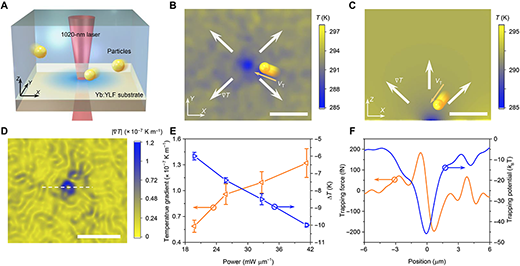| Jun 29, 2021 | |
Opto-refrigerative tweezers can dynamically manipulate objects at a laser-generated cold spot |
|
| (Nanowerk Spotlight) Optical trapping and manipulation of micrometer-sized particles was first reported in 1970. Since then, it has been successfully implemented in two size ranges: the nano- and sub-nanometer scale, where light–matter mechanical coupling enables cooling of atoms, ions and molecules, and the micrometer scale, where the momentum transfer resulting from light scattering allows manipulation of microscopic objects such as cells (Source). | |
| This rapidly growing technology opened up a wide variety of research applications. Optical tweezers operate by trapping particles at the focal points of tightly focused laser beams, allowing researchers to manipulate the objects without any physical contact. | |
| The importance of this technique was recognized in 2018, when one-half of the Nobel Prize was awarded to Arthur Ashkin, the physicist who invented optical tweezers that grab particles, atoms, viruses and other living cells with their laser beam fingers. This new tool allowed Ashkin to realize an old dream of science fiction – using the radiation pressure of light to move physical objects. He succeeded in getting laser light to push small particles towards the center of the beam and to hold them there. Optical tweezers had been invented. | |
| Optical tweezers used to trap nanoscale objects usually require a tightly focused laser beam with high optical intensity. The problem with all conventional laser-based optical manipulation techniques – including conventional optical tweezers, plasmonic tweezers, and optothermal tweezers – is that the laser light could cause photodamages and photothermal degradation to nanoparticles and biological samples. | |
| Reporting their findings in Science Advances ("Opto-refrigerative tweezers"), researchers have now developed a novel solution to this problem: Creating a low-temperature spot in the solution and trap particles and molecules at the cold spot. This new technique can effectively avoid photothermal damages. | |
| "Our opto-refrigerative tweezers (ORTs) can be used to dynamically manipulate objects at a laser-generated cold spot enabled by optical refrigeration and thermophoresis synergy," Jingang Li, a member of the Zheng Research Group at UT Austin and the paper's first author, explains to Nanowerk. "The localized laser cooling of the substrate generates a nonuniform temperature gradient field in the solution, in which colloidal particles and molecules can be trapped at the low-temperature region – i.e., the laser spot – via thermophoresis." | |
 |
|
| Working principle of ORT. (A) Schematic of the localized laser cooling of Yb:YLF substrate and the thermophoretic trapping of particles at the cold spot. (B) Measured in-plane temperature distribution at the solution-substrate interface under a laser intensity of 25.8 mW µm−2. (C) Simulated out-of-plane temperature distribution based on the temperature profile crossing the laser beam center in (B). (D) In-plane temperature gradient mapping corresponding to (B). (E) Power-dependent laser cooling. The average temperature drops at the laser beam center, and the peripheral temperature gradient values were plotted. (F) The effective thermophoretic trapping force and the trapping potential along the white dashed line in (D). A Soret coefficient of 4 K−1 was used. The position of the laser beam center was set to be 0. Scale bars, 10 µm. (Reprinted with permission by American Association for the Advancement of Science) (click on image to enlarge) | |
| The team points out that, besides providing a general platform to trap nanoparticles and molecules with thermophobic nature based on thermophoresis, ORT stands out for research in colloidal sciences and biology due to the capability to trap and manipulate objects with low damages. | |
| "Compared to optical tweezers, ORT relies on a temperature gradient field to trap the target objects," says Dr. Yuebing Zheng. "Therefore, we used a weakly focused laser beam – numerical aperture = 0.5 to 0.7 – with lower intensity to significantly reduce the photodamages." | |
| The result is a safe way to trap and manipulate various thermosensitive nanoparticles and molecules, such as fluorescent particles and protein molecules, which remains challenging for existing techniques. It also enables the investigation of the interactions between these thermosensitive materials. | |
| As a newly developed technique, ORT still has several limitations and future efforts that can be made to further enhance its strengths. | |
| The team's next steps include the optimization of the configurations in their opto-refrigerative tweezers, such as the substrate, to further enhance its capabilities. They are also planning to apply these new tweezers for biological applications, such as studying molecular interactions in cells. | |
 By
Michael
Berger
– Michael is author of three books by the Royal Society of Chemistry:
Nano-Society: Pushing the Boundaries of Technology,
Nanotechnology: The Future is Tiny, and
Nanoengineering: The Skills and Tools Making Technology Invisible
Copyright ©
Nanowerk LLC
By
Michael
Berger
– Michael is author of three books by the Royal Society of Chemistry:
Nano-Society: Pushing the Boundaries of Technology,
Nanotechnology: The Future is Tiny, and
Nanoengineering: The Skills and Tools Making Technology Invisible
Copyright ©
Nanowerk LLC
|
|
|
Become a Spotlight guest author! Join our large and growing group of guest contributors. Have you just published a scientific paper or have other exciting developments to share with the nanotechnology community? Here is how to publish on nanowerk.com. |
|
